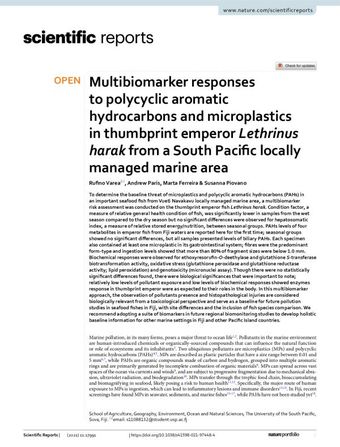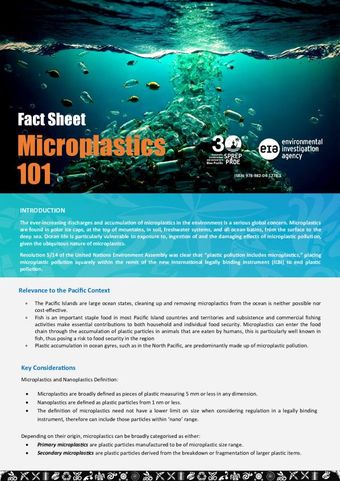Microplastic pollution identified in deep-sea water and ingested by benthic invertebrates in the Rockall Trough, North Atlantic Ocean
- Description:
- Microplastics are widespread in the natural environment and present numerous ecological threats. While the ultimate fate of marine microplastics are not well known, it is hypothesized that the deep sea is the nal sink for this anthropogenic contaminant. This study provides a quanti cation and characterisation of microplastic pollution ingested by benthic macroinvertebrates with different feeding modes (Ophiomusium lymani, Hymenaster pellucidus and Colus jeffreysianus) and in adjacent deep water> 2200 m, in the Rockall Trough, Northeast Atlantic Ocean. Despite the remote location, microplastic bres were identi ed in deep-sea water at a concentration of 70.8 particles m 3, comparable to that in surface waters. Of the invertebrates examined (n ¼ 66), 48% ingested microplastics with quantities enumerated comparable to coastal species. The number of ingested microplastics differed signi cantly between species and generalized linear modelling identi ed that the number of microplastics ingested for a given tissue mass was related to species and not organism feeding mode or the length or overall weight of the individual. Deep-sea microplastics were visually highly degraded with surface areas more than double that of pristine particles. The identi cation of synthetic polymers with densities greater and less than sea water along with comparable quantities to the upper ocean indicates processes of vertical re-distribution. This study presents the rst snapshot of deep ocean microplastics and the quanti cationofmicroplasticpollutionintheRockallTrough.Additionalsamplingthroughoutthedeepseaisrequiredtoassesslevelsofmicroplasticpollution,verticaltransportationandsequestration,which have the potential to impact the largest global ecosystem.
- Display date:
- 2017
- Collections:
- Secretariat of the Pacific Regional Environment Programme (SPREP)
- Publisher:
- Elsevier Ltd.
- Content partner:
- Secretariat of the Pacific Regional Environment Programme (SPREP)
- Availability:
- Not specified
-
Copyright status: All rights reservedFind out more about what you are able to do with this itemThis item is all rights reserved, with means you'll have to get permission from Secretariat of the Pacific Regional Environment Programme (SPREP) before using it. For more information, please see our use and reuse page.What can I do with this item?Non-infringing useNZ copyright law does not prevent every use of a copyright work, and this item may be hosted by an international institute or organisation. You should consider what you can and cannot do with a copyright work.No sharingYou may not copy and/or share this item with others without further permission. This includes posting it on your blog, using it in a presentation, or any other public use.No modifyingYou are not allowed to adapt or remix this item into any other works.No commercial useYou may not use this item commercially.
Related items
Welcome and warm Pasifik greetings
The information on this site has been gathered from our content partners.
The names, terms, and labels that we present on the site may contain images or voices of deceased persons and may also reflect the bias, norms, and perspective of the period of time in which they were created. We accept that these may not be appropriate today.
If you have any concerns or questions about an item, please contact us.

